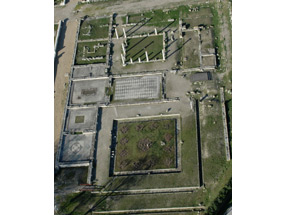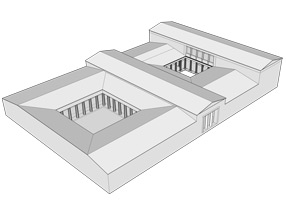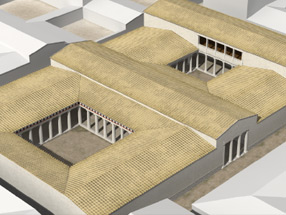Virtual Reality: Pella
Virtual reality representation of the “House of Dionysos” in Pella created by the Foundation of the Hellenic World
The virtual reconstruction of the “House of Dionysos” in Pella represents the oldest phase of the building, at the beginning of the Hellenistic period. The house is surrounded by a simplified version of the urban landscape so as to give a general idea of the original surroundings.
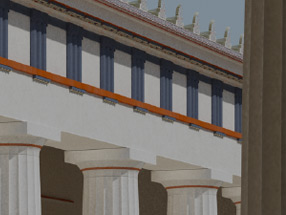 The oldest phase of the house dates back to the late fourth century BC and has two large courtyards, one with Doric and one with Ionic colonnade. These courtyards are separated by a central wing with a monumental entrance. The south wing has a second floor. The interior of the section for men, called Andron, is represented as in a day of a symposium, with beds, vases and other objects, the design of which is based on discoveries from the same period, brought to light in Macedonia.
The oldest phase of the house dates back to the late fourth century BC and has two large courtyards, one with Doric and one with Ionic colonnade. These courtyards are separated by a central wing with a monumental entrance. The south wing has a second floor. The interior of the section for men, called Andron, is represented as in a day of a symposium, with beds, vases and other objects, the design of which is based on discoveries from the same period, brought to light in Macedonia.
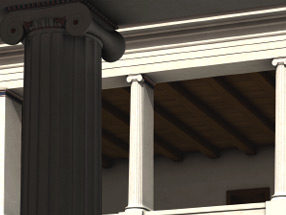 The house is restored according to scientific publications and, in some cases, with the use of architectural details preserved in the neighboring houses, found in excavations. The Doric peristyle, for example, has been recreated according to the peristyle that is better preserved in the “House of the abduction of Helen”. Following the example of another antechamber of the same house overlooking the court with the Ionic peristyle, the facades of each antechamber of the Andron with the mosaic floors are represented by pillars in series. Four of these pillars form a triple entry. On both sides of the entry there are two smaller pillars creating a type of side windows. This is a typical arrangement in Macedonia and it is inspired by similar provisions as in the palace of Pella and Vergina.
The house is restored according to scientific publications and, in some cases, with the use of architectural details preserved in the neighboring houses, found in excavations. The Doric peristyle, for example, has been recreated according to the peristyle that is better preserved in the “House of the abduction of Helen”. Following the example of another antechamber of the same house overlooking the court with the Ionic peristyle, the facades of each antechamber of the Andron with the mosaic floors are represented by pillars in series. Four of these pillars form a triple entry. On both sides of the entry there are two smaller pillars creating a type of side windows. This is a typical arrangement in Macedonia and it is inspired by similar provisions as in the palace of Pella and Vergina.
The reconstruction of the roof only utilizes tiles and antefixes that match the first phase of construction before any repairs or additions. The murals are made with darker colors in the lower walls while the top is bright. The findings of the “House of mortars” are used as guideline. Digital images of high resolution provide evidence for the Androns, their entrances and their antechambers.
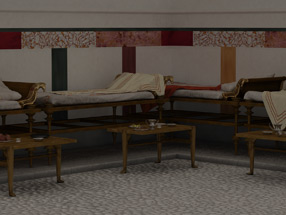
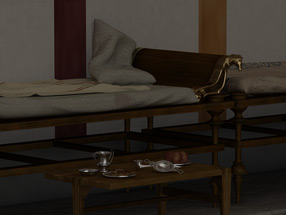
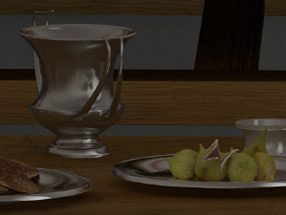 In the Andron “of the lion hunt”, a symposium scene is represented with beds and tables that are not exact replicates but represent similar objects found in Macedonian tombs (Potidaea, Vergina, Aghios Athanasios and Ganos). Fabric designs and mattresses on beds are inspired by similar designs of the ceramic art of Attica and specialized studies on beds in ancient Greece.
In the Andron “of the lion hunt”, a symposium scene is represented with beds and tables that are not exact replicates but represent similar objects found in Macedonian tombs (Potidaea, Vergina, Aghios Athanasios and Ganos). Fabric designs and mattresses on beds are inspired by similar designs of the ceramic art of Attica and specialized studies on beds in ancient Greece.
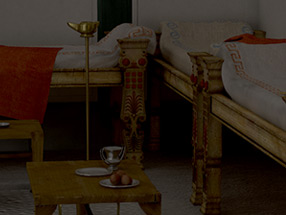 The symposium room is furnished with silver, bronze and clay vases, as well as with other objects used in these events (lamps, candelabras). The selection has been made amongst those artifacts presented in the Louvre museum (Derveni, Vergina).
The symposium room is furnished with silver, bronze and clay vases, as well as with other objects used in these events (lamps, candelabras). The selection has been made amongst those artifacts presented in the Louvre museum (Derveni, Vergina).
Finally, in the Andron “Dionysus”, a bed of late Hellenistic type with turned legs and decoration of bronze fulcrum is reconstructed according to discoveries found in Pella that are also included in the Louvre museum exhibition.
